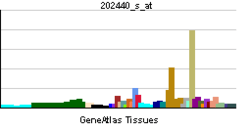ST5 (gene)
| ST5 | ||||||
|---|---|---|---|---|---|---|
| Identifiers | ||||||
| Aliases | ST5, DENND2B, HTS1, p126, suppression of tumorigenicity 5 | |||||
| External IDs | MGI: 108517 HomoloGene: 3951 GeneCards: ST5 | |||||
| RNA expression pattern | ||||||
 | ||||||
| More reference expression data | ||||||
| Orthologs | ||||||
| Species | Human | Mouse | ||||
| Entrez | ||||||
| Ensembl | ||||||
| UniProt | ||||||
| RefSeq (mRNA) | ||||||
| RefSeq (protein) | ||||||
| Location (UCSC) | Chr 11: 8.69 – 8.91 Mb | Chr 7: 109.52 – 109.7 Mb | ||||
| PubMed search | [1] | [2] | ||||
| Wikidata | ||||||
| View/Edit Human | View/Edit Mouse |
Suppression of tumorigenicity 5 is a protein that in humans is encoded by the ST5 gene.[3][4] ST5 orthologs [5] have been identified in nearly all mammals for which complete genome data are available.
Function
This gene was identified by its ability to suppress the tumorigenicity of Hela cells in nude mice. The protein encoded by this gene contains a C-terminal region that shares similarity with the Rab 3 family of small GTP binding proteins. This protein preferentially binds to the SH3 domain of c-Abl kinase, and acts as a regulator of MAPK1/ERK2 kinase, which may contribute to its ability to reduce the tumorigenic phenotype in cells. Three alternatively spliced transcript variants of this gene encoding distinct isoforms are identified.[4]
References
- ↑ "Human PubMed Reference:".
- ↑ "Mouse PubMed Reference:".
- ↑ Lichy JH, Modi WS, Seuanez HN, Howley PM (August 1992). "Identification of a human chromosome 11 gene which is differentially regulated in tumorigenic and nontumorigenic somatic cell hybrids of HeLa cells". Cell Growth & Differentiation. 3 (8): 541–8. PMID 1390339.
- 1 2 "Entrez Gene: ST5 suppression of tumorigenicity 5".
- ↑ "OrthoMaM phylogenetic marker: ST5 coding sequence".
Further reading
- Lichy JH, Majidi M, Elbaum J, Tsai MM (December 1996). "Differential expression of the human ST5 gene in HeLa-fibroblast hybrid cell lines mediated by YY1: evidence that YY1 plays a part in tumor suppression". Nucleic Acids Research. 24 (23): 4700–8. doi:10.1093/nar/24.23.4700. PMC 146314
 . PMID 8972856.
. PMID 8972856. - Majidi M, Hubbs AE, Lichy JH (June 1998). "Activation of extracellular signal-regulated kinase 2 by a novel Abl-binding protein, ST5". The Journal of Biological Chemistry. 273 (26): 16608–14. doi:10.1074/jbc.273.26.16608. PMID 9632734.
- Hubbs AE, Majidi M, Lichy JH (April 1999). "Expression of an isoform of the novel signal transduction protein ST5 is linked to cell morphology". Oncogene. 18 (15): 2519–25. doi:10.1038/sj.onc.1202554. PMID 10229203.
- Majidi M, Gutkind JS, Lichy JH (March 2000). "Deletion of the COOH terminus converts the ST5 p70 protein from an inhibitor of RAS signaling to an activator with transforming activity in NIH-3T3 cells". The Journal of Biological Chemistry. 275 (9): 6560–5. doi:10.1074/jbc.275.9.6560. PMID 10692462.
- Amid C, Bahr A, Mujica A, Sampson N, Bikar SE, Winterpacht A, Zabel B, Hankeln T, Schmidt ER (2001). "Comparative genomic sequencing reveals a strikingly similar architecture of a conserved syntenic region on human chromosome 11p15.3 (including gene ST5) and mouse chromosome 7". Cytogenetics and Cell Genetics. 93 (3-4): 284–90. doi:10.1159/000056999. PMID 11528127.
- Colland F, Jacq X, Trouplin V, Mougin C, Groizeleau C, Hamburger A, Meil A, Wojcik J, Legrain P, Gauthier JM (July 2004). "Functional proteomics mapping of a human signaling pathway". Genome Research. 14 (7): 1324–32. doi:10.1101/gr.2334104. PMC 442148
 . PMID 15231748.
. PMID 15231748. - Benzinger A, Muster N, Koch HB, Yates JR, Hermeking H (June 2005). "Targeted proteomic analysis of 14-3-3 sigma, a p53 effector commonly silenced in cancer". Molecular & Cellular Proteomics. 4 (6): 785–95. doi:10.1074/mcp.M500021-MCP200. PMID 15778465.
- Olsen JV, Blagoev B, Gnad F, Macek B, Kumar C, Mortensen P, Mann M (November 2006). "Global, in vivo, and site-specific phosphorylation dynamics in signaling networks". Cell. 127 (3): 635–48. doi:10.1016/j.cell.2006.09.026. PMID 17081983.
This article is issued from Wikipedia - version of the 6/6/2016. The text is available under the Creative Commons Attribution/Share Alike but additional terms may apply for the media files.